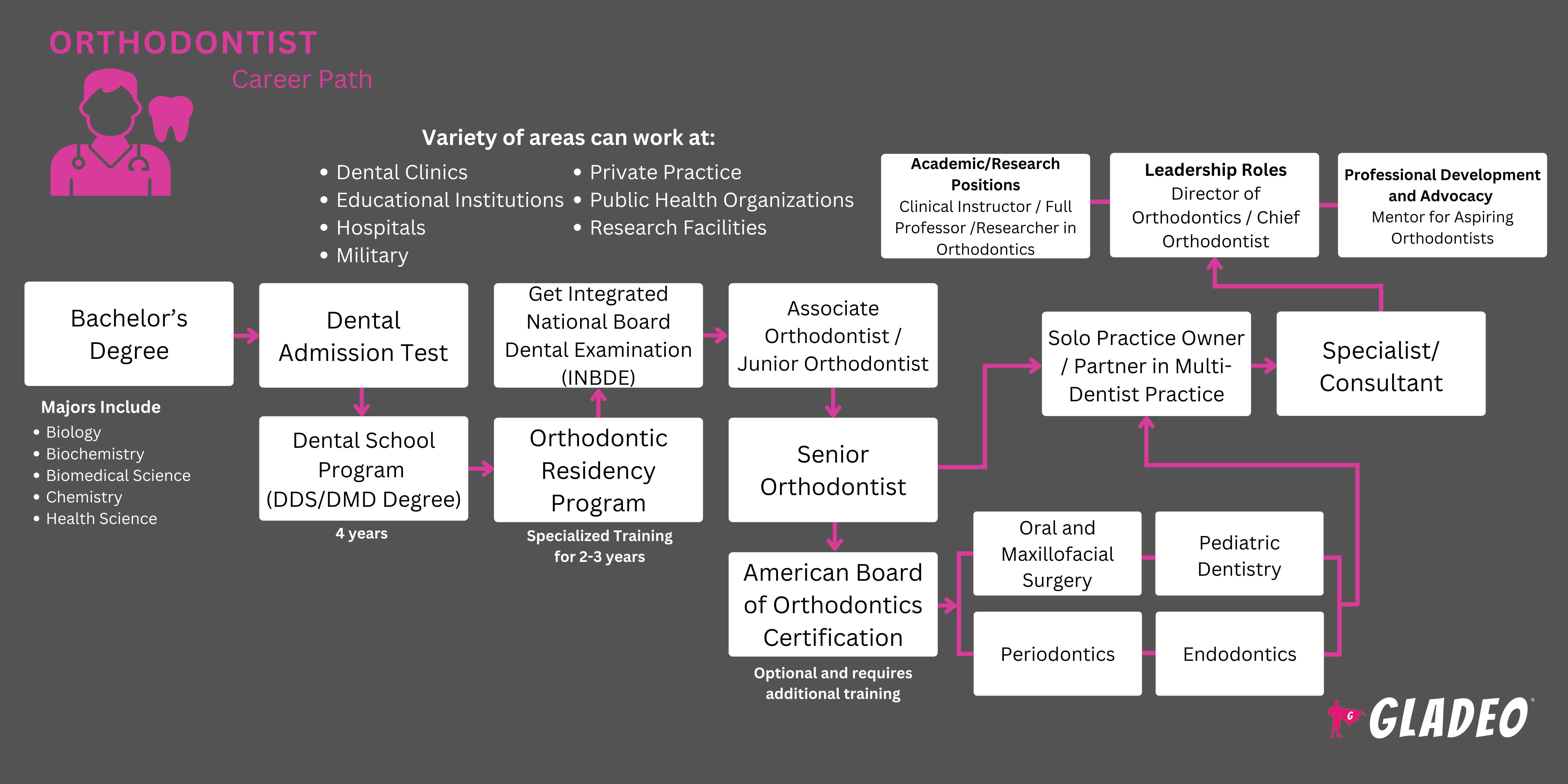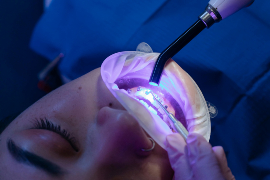Spotlights
Board Certified Orthodontist, Orthodontic Dentist, Orthodontic Specialist, Orthodontics and Dentofacial Orthopedics Specialist, Orthodontics Doctor, Orthodontist
Only about 35% of Americans have naturally straight teeth, while the majority have to deal with misalignments, overbites, underbites, or other issues. So if you’ve ever seen someone with perfect teeth, there’s a chance they had some orthodontic work done at some point in their lives.
Orthodontists are specialized dentists who diagnose, treat, and prevent irregularities in teeth and jaws using braces, aligners, bands, and retainers. These treatment methods are relatively slow, taking several months to gently push teeth into proper position. Patients must come in regularly for adjustments and check-ups, but the investment of time, money, and periodic discomfort is usually worth it. Meanwhile, Orthodontists get the satisfaction of helping patients enjoy improved dental health!
- Helping patients achieve and maintain proper alignment and oral health.
- Identifying and correcting dental problems to improve functionality and appearance.
- High earning potential and a strong job outlook in a specialized field.
Lịch làm việc
Orthodontists typically work full-time in private practices, dental offices, or specialty clinics. They focus on treating patients but may also manage administrative and business-related duties.
Nhiệm vụ tiêu biểu
- Conduct initial consults with patients to review their concerns and goals and go over costs and payment options.
- Note, the average cost of braces ranges from $3,000 to $10,000. Not all patients have insurance that will cover the total costs, so many orthodontic clinics offer no-interest payment plans.
- Use diagnostic tools like X-rays, 3D scans, and photographs to assess dental issues that need to be addressed.
- Diagnose malocclusions (improper bites) and other orthodontic problems.
- Develop detailed, customized treatment plans for correcting irregularities.
- Take impressions and digital scans of patients’ teeth for appliance fabrication.
- Fit orthodontic appliances such as braces, aligners, and expanders over the patient’s teeth.
- Adjust appliances as needed during follow-up visits.
- Educate patients on the importance of maintaining oral hygiene during orthodontic care.
- Monitor treatment progress and adjust as needed.
- Recommend the use of removable or fixed retainers to maintain teeth alignment after treatment.
- Because orthodontic treatment takes so long and is expensive, the long-term use of retainers is often suggested to keep teeth from shifting out of proper position.
Nhiệm vụ bổ sung
- Review patient treatment charts before appointments and update records afterward.
- Use software to design and simulate orthodontic treatment outcomes.
- Train and supervise assistants and other staff.
- Ensure instruments are sterilized and maintained.
- Keep up to date on advancements in orthodontic techniques, materials, and technology.
- Collaborate with oral surgeons as needed.
- Manage business-related duties, if in private practice, such as accounting, paying taxes, marketing, office management, human resources tasks, etc.
Kỹ năng mềm
- Chú ý đến chi tiết
- Cách thức bên giường bệnh
- Sự nhạy bén trong kinh doanh và kỹ năng tiếp thị (đối với những người hành nghề tư nhân)
- Truyền thông
- Điềm tĩnh
- Dịch vụ khách hàng
- Độ tin cậy
- Khéo léo
- Sự siêng năng
- Cảm
- Tập trung
- Phối hợp tay-mắt
- Phương pháp
- Tinh ý
- Kỹ năng tổ chức
- Kiên nhẫn
- Giải quyết vấn đề
- Ý thức an toàn
- Phán xét hợp lý
- Làm việc theo nhóm
- Quản lý thời gian
Kỹ năng kỹ thuật
Orthodontists need hard skills related to the following:
- 3D imaging and digital diagnostics, such as cone-beam computed tomography and intraoral scanners
- Dental radiology (taking and analyzing orthodontic X-rays and panoramic imaging)
- Infection control and sterilization standards
- Knowledge of applicable regulations
- Knowledge of dental anatomy and biomechanics, such as understanding tooth movement and jaw structure
- Medical record-keeping
- Orthodontic appliance fitting and adjustments (i.e., braces, aligners, retainers, and expanders)
- Orthodontic procedures (applying braces, bonding brackets, and placing retainers)
- Orthodontic software like Invisalign ClinCheck, OrthoCAD, or Dolphin Imaging
- Patient care protocols
- Taking dental impressions and digital scanning to create molds or digital models for appliance fabrication
- Treatment planning using diagnostic tools to create detailed plans for teeth and jaw alignment
- Private practices
- Multi-speciality dental clinics
- Community health clinics
- Bệnh viện
- Colleges
- Military branches
- Research labs
- Tổ chức phi lợi nhuận
- Orthodontic equipment companies
Orthodontists must complete several years of rigorous education and specialized training, including undergraduate studies, dental school, and a residency in orthodontics. This extended period of education can result in a lot of student debt that can take years to repay.
Once in practice, Orthodontists have to maintain a high level of precision and attention to detail. Patients rely on their ability to accurately diagnose and treat complex dental issues where even minor errors can lead to costly or painful consequences. Even after graduating, Orthodontists must continue to stay updated with advancements in orthodontic techniques and technologies.
Orthodontists in private practice are not only healthcare providers but also business owners! They have to manage or oversee finances, marketing, hiring and training staff, and ensuring compliance with healthcare regulations. They’ve also got to maintain liability insurance in case of a malpractice claim.
All this work naturally requires long hours which can take a toll on their work-life balance. However, the job can be financially rewarding, especially for those who run successful practices. In addition, Orthodontists have the satisfaction of improving patients’ oral health and overall quality of life.
Trends in the orthodontics field include new applications like clear aligners, high-tech 3D imaging tools, and even AI-driven software to streamline workflows and improve patient outcomes. Devices like vibration-based accelerators and advanced wires speed up tooth movement, while 3D printing is enabling faster creation of custom appliances like aligners and retainers.
Teleorthodontics has expanded access to care, allowing remote consultations and monitoring for patients in underserved areas. Meanwhile, early intervention efforts with pediatric dentists are helping to address issues like jaw misalignment before they become more serious and require invasive treatments. Finally, sustainable practices are gaining traction with many offices adopting eco-friendly products and waste reduction strategies.
Orthodontists often share an early interest in science, particularly biology and health. They may have enjoyed hands-on activities, such as crafts or hobbies requiring fine motor skills.
- Orthodontists are highly-trained dental specialists who must meet rigorous educational and licensing requirements to practice.
- Bachelor degree majors vary, but majoring in biology, chemistry, biochemistry, health science, or biomedical science can help lay the foundation for dental school.
- Các khóa học phổ biến bao gồm:
- Hoá sinh học
- Sinh học
- Hóa học
- Mathematics (calculus, statistics, etc.)
- Organic Chemistry
- Vật lý học
- Orthodontists must earn either a Doctor of Dental Surgery (DDS) or a Doctor of Dental Medicine (DMD) degree from a dental school accredited by the Commission on Dental Accreditation.
- Admission to dental school requires strong scores on the Dental Admission Test, a 4.5-hour exam administered at Prometric test sites. Test sections include:
- Survey of Natural Sciences (100 questions)
- Perceptual Ability (90 questions)
- Reading Comprehension (50 questions)
- Quantitative Reasoning (40 questions)
- After admission, dental school programs last ~4 years with coursework in:
- Giải phẫu học
- X quang
- Periodontics
- Anesthesia
- Advanced clinical dentistry.
- Students also complete supervised clinical practice. After earning their DDS or DMD, Orthodontists next go to a ~2 or 3 year residency to get training in diagnosing and treating malocclusions and dental-facial irregularities. Some programs offer postdoctoral certificates, as well.
- Once all training is completed, Orthodontists have to pass the Integrated National Board Dental Examination (INBDE) to get licensure in their state. Some states have additional requirements.
- Administered by the Joint Commission on National Dental Examinations, the INBDE evaluates a candidate’s clinical judgment, problem-solving, and ability to apply foundational knowledge in dental practice.
- The exam takes 1.5 days and consists of ~500 multiple-choice questions, covering both discipline-based content (e.g., anatomy, pathology) and clinical scenarios. It emphasizes assessing practical, integrative knowledge rather than memorization.
- Results are pass or fail based on overall performance.
- Certification by the American Board of Orthodontics is optional and requires additional training. Advanced specialties include:
- Oral and Maxillofacial Surgery (requiring a residency or fellowship of up to 6 years)
- Pediatric Dentistry (~2 - 3 years of specialized residency training)
- Periodontics (~2 - 3 years of specialized residency training)
- Endodontics (~2 - 3 years of specialized residency training)
- Orthodontists who want to focus on research or teaching can also pursue additional postdoctoral training.
- Continuous education is a fundamental aspect of this career field and is necessary to maintain licensure and to keep up with new technologies, techniques, and best practices.
- Dental schools are tough to get into, so you need to be very well-prepared! That includes knocking out your bachelor’s in a relevant major while maintaining a strong GPA.
- Look for undergrad programs that are accredited and feature the rigorous foundational coursework you’ll need to succeed at dental school.
- Xem xét tiểu sử giảng viên và giải thưởng; xem chương trình sử dụng những loại cơ sở vật chất và thiết bị hiện đại nào; kiểm tra nghiên cứu của họ và các đối tác thực tập của họ; tìm hiểu về tỷ lệ tốt nghiệp và số liệu thống kê vị trí việc làm; và nhìn vào những thành tựu của mạng lưới cựu sinh viên!
- Other general considerations include tuition costs (in-state/out-of-state rates), discounts, scholarships, and course delivery options (on-campus, online, or hybrid program).
- Look for dental school programs accredited by the Commission on Dental Accreditation (CODA) and featuring access to clinical opportunities, experienced faculty, and facilities with modern dental equipment.
- Use the CODA-accredited dental education program finder to search for schools in each state.
- Take college prep classes in high school, including anatomy, physiology, biology, chemistry, math, physics, calculus, statistics, English composition, psychology, and communications.
- Study hard to earn good grades so you can get accepted into a suitable undergrad program.
- Choose your undergraduate major wisely. Popular options include biology, chemistry, biochemistry, health science, and biomedical science.
- Think about the format you want to take classes in. Some classes are fine for online study, but others will need to be done in-person or hybrid.
- Study for the Dental Admission Test so you can get into dental school.
- Plan ahead by looking at other dental school requirements early on! Find out about internships and residencies.
- Practice your interview skills before applying to dental school.
- Join dental student organizations to make friends, learn from each other, and stay motivated for the long journey!
- Keep a list of contacts (including phone numbers or emails) who might serve as future references.
- Read or watch interviews with Orthodontists to learn about their daily work routine.
- Check out journal articles (such as in the American Journal of Orthodontics and Dentofacial Orthopedic) and video tutorials about Orthodontic specialties.
- Learn about the specific licensure requirements for the state you plan to work in. Stay out of trouble so you can pass a criminal background check if required for licensure in your state.
- Develop a workout schedule so you can stay in shape and manage stress.

- Visit your dental school’s career center for help with job placement, resume preparation, and interview practice.
- During residency, build professional relationships and leverage these connections to learn about openings.
- Note that most Orthodontists start as associates, working under an established practice owner or larger dental group.
- Ensure you’ve met your state licensure requirements.
- Prepare a professional resume and cover letter. If needed, review online templates for help.
- Make a list of personal references. Ask their permission before sharing their contact details.
- Check sites like Indeed.com, DentalPost, and the American Association of Orthodontists for postings.
- Maintain a professional LinkedIn profile and let everyone know you’re available for work.
- Obtain board certification in a speciality like oral and maxillofacial surgery, pediatric dentistry, periodontics, or endodontics to boost your credentials and prospects.
- Attend workshops, seminars, and continuing education courses to stay updated on advancements.
- Demonstrate leadership and teamwork skills at all times, no matter where you’re working!
- Participate in professional organizations to grow your network and discover opportunities. Offer to give lectures or presentations, submit articles to peer-reviewed journals, and build your reputation within the community!
- Mentor students and associate Orthodontists with patience and hold them to high standards.
- Consider teaching or research positions and knock out any required training to qualify for them.
- Learn about private practice management, finance, and marketing if you want to open your own practice.
- Think carefully about where you want to work. Some states and cities have more potential patients but may also have a lot of competition already established.
- The states with the highest employment level for Orthodontists are California, New Jersey, New York, Virginia, and South Carolina. However, the states with the highest concentration of jobs are Maine, South Carolina, New Jersey, Oregon, and Alabama.
- Read industry publications and try out new innovations at your practice.
- Develop strong interpersonal skills to improve patient satisfaction – and get repeat business, positive reviews, and referrals.
Trang web
- Học viện Nha khoa Tổng quát
- Academy of Laser Orthodontistry
- Học viện Nha khoa Thẩm mỹ Hoa Kỳ
- Học viện Nha khoa Implant Hoa Kỳ
- Học viện X quang răng miệng và hàm mặt Hoa Kỳ
- Học viện Nha khoa Nhi khoa Hoa Kỳ
- Hiệp hội các bác sĩ phẫu thuật răng miệng và hàm mặt Hoa Kỳ
- Hiệp hội chỉnh nha Hoa Kỳ
- Hiệp hội Nha khoa Y tế Công cộng Hoa Kỳ
- American Board of Orthodontics
- Hiệp hội Nha khoa Hoa Kỳ
- Hiệp hội Nha khoa Hoa Kỳ, Ủy ban Công nhận Nha khoa
- Hiệp hội Giáo dục Nha khoa Hoa Kỳ
- American Journal of Orthodontics and Dentofacial Orthopedic
- American Society of Orthodontist Anesthesiologists
- Angle Orthodontist
- Centers for Disease Control and Prevention – Oral Health Division
- Ủy ban công nhận nha khoa
- DentalCare.com
- International Federation of Orthodontists
- Journal of Clinical Orthodontics
- National Institute of Dental and Craniofacial Research
- National Orthodontists' Association
- Orthodontic Practice US
- Orthodontic Product
- The Digital Orthodontist
- The Ortho Cosmos
- World Federation of Orthodontists
Sách vở
- Handbook of Orthodontics, by Martyn Cobourne BDS (HONS) FDSRCS MSC PHD FHEA and Andrew DiBiase BDS (HONS) FDSRCS MSC
- Orthodontics: Current Principles and Techniques, by Lee W. Graber DDS MS MS PhD, et. al.
- Wilkins’ Clinical Practice of the Orthodontist, by Linda D. Boyd, et. al.
Orthodontists are important front-line members of the healthcare community, but there are plenty of other professions to consider if this career isn’t resonating with you. Check out our list below for some ideas!
- Allergist
- Bác sĩ gây mê
- Cardiologist
- Trợ lý điều dưỡng được chứng nhận
- Bác sĩ nắn xương
- Nha sĩ
- Dermatologist
- Emergency Medicine Physician
- General Internal Medicine Physician
- Y tá dạy nghề được cấp phép
- Neurologist
- Y tá gây mê
- Y tá hộ sinh
- Y tá hành nghề
- Obstetrician and Gynecologist
- Ophthalmologist
- Optometrist
- Pediatrician
- Vật lý trị liệu
- Trợ lý bác sĩ
- Podiatrist
- Psychiatrist
- Bác sĩ X quang
- Y tá đã đăng ký
- Trợ lý điều dưỡng phục hồi
- Sports Medicine Physician
- Surgeon
- Urologist
Nguồn cấp tin tức

Việc làm nổi bật

Các khóa học và công cụ trực tuyến








